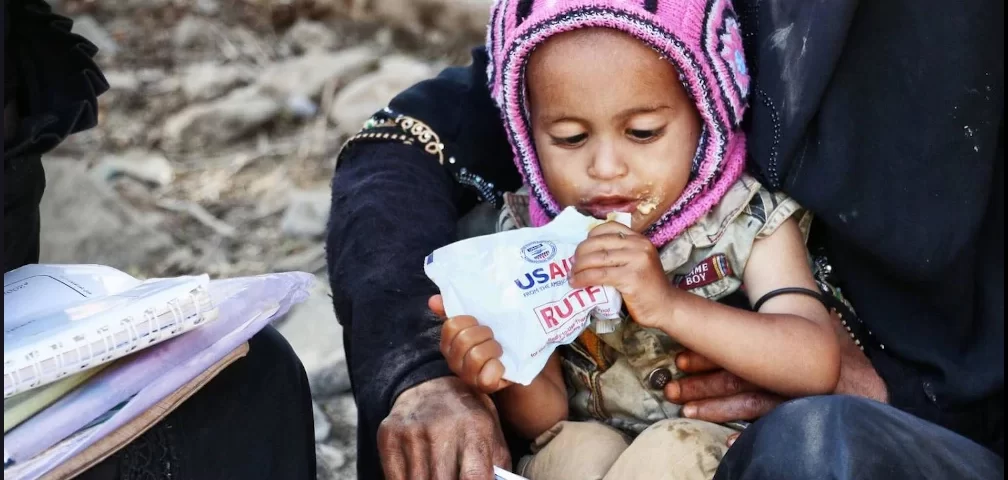from the News Desk at The Cradle, published on December 13, 2022
As the Saudi-instigated war in Yemen inches towards its eight year, investigative reports have come to show that billions of dollars in humanitarian aid managed by international organizations have done very little to alleviate the suffering of millions of Yemenis, who often receive as little as 20 percent of the funds intended to help them.
Instead of their stated aim, a large portion of the aid funds stay in the pockets of NGOs to pay for ‘administrative costs,’ which include building large fortifications around their offices and purchasing armored vehicles for their employees, in what has come to be known as the “bunkerization” of western aid agencies.
Among the most egregious examples of the misuse of funds are those managed by the World Food Programme (WFP). Since the start of the war, the WFP has received over $12 billion for Yemen within the framework of the UN Humanitarian Response Project.
However, while the WFP has for years warned about the critical levels of malnourishment among Yemen’s 31 million citizens, the UN agency often fails to mention how its agents are known to import large quantities of spoiled food at low prices, while redirecting large chunks of the aid to pay for administrative costs.
According to documents reviewed by Lebanese daily Al Akhbar, 93,563 tons of spoiled vegetables and 362,880 tons of expired food supplements for pregnant women and children under five years of age have been distributed by the WFP over recent years to tens of thousands of Yemenis.
Moreover, more than a quarter million tons of expired cooking oil were returned to the source country, while 440,000 tons of aid have been destroyed due to the poor storage conditions of WFP warehouses.
The UN agency’s rampant mismanagement of funds has turned into one of the leading causes for the hunger crisis gripping the Arab world’s poorest nation, where 17 million Yemenis are food insecure and 1.3 million pregnant or breastfeeding women – as well as 2.2 million children under five – require treatment for acute malnutrition, according to the WFP itself.
According to UNICEF, only 15 percent of severely malnourished children receive the minimum amount of food to survive in Yemen. Despite the stark figures, in 2020 the WFP was awarded the Nobel Peace Prize “for its efforts to combat hunger.”
The strategies of western NGOs in general clash with the real life needs of Yemenis, as aid agencies are more likely to focus on implementing their own agendas, which typically have a temporary, short-term impact, and which mainly aim to satisfy donors and meet their expectations.
In June of this year, the UK-based Institute of Development Studies (IDS) called UN aid delivered to Yemen “unacceptably poor,” claiming that the spending of $16 billion obtained since the start of the war is rife with “loopholes, abuses, poor planning, lack of coordination, lack of oversight, and failure to reach the most vulnerable.”
“Widespread examples included camps for internally displaced people with no toilets, roads left half-finished, faulty agricultural equipment supplied, and new schools badly built. Hospital equipment also did not work or could not be used; for example, expensive X-ray machines left idle because no ink was available to print the images,” the IDS report highlights.
Other western organizations have also failed to fulfill their promises to help the people of Yemen, chief among the US Agency for International Development (USAID) and the European Commission.
An example of USAID mismanagement is the so-called “Yemen Communities Stronger Together” (YCST) initiative, which was implemented between 2018 and 2022 and aimed to “[support] local-level initiatives that mitigate conflict, strengthen social cohesion, and promote the peaceful resolution of differences.”
Nonetheless, out of a cost of $11.6 million in US taxpayer funds, 78 percent was used to pay for administrative expenses, leaving only $2.5 million for the community the plan intended to help.
Similarly, the European Commission in 2019 funded a one-year project “to improve living conditions in the camps for displaced Yemenis” to $1.3 million. However, more than $700,000 was spent on administrative expenses, and less than $400,000 was left for displaced Yemenis.
Late last month, USAID hailed the implementation of an $18 million school rehabilitation program that allegedly benefits “407,000 young students,” with support from UNICEF. Yemeni activists soon denounced that the rehabilitation project cost no more than $2 million, raising questions about where the remaining funds were diverted.
Sources within Yemen’s National Salvation Government (NSG) who spoke with Al Akhbar say western aid agencies often refuse to deliver aid to provinces not under the control of the Saudi-led coalition, as Riyadh has declared them “active war zones” or “high-risk” regions since 2015.
The officials claim this behavior aligns with the “desires and directions of the countries of aggression.”
The Saudi-appointed Transitional Presidential Council (TPC) has also been escalating pressure on western aid agencies operating in Sanaa to move to the southern city of Aden, as part of the coalition’s attempts to label the Ansarallah resistance group as a terrorist organization.
On top of this, the Central Bank of Aden recently issued a circular directing international and local organizations to transfer their assets to banks subject to the Saudi-led coalition’s control under the threat of punitive measures.
